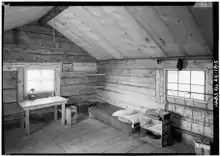Cabin fever
Cabin fever is the distressing claustrophobic irritability or restlessness experienced when a person, or group, is stuck at an isolated location or in confined quarters for an extended time.[1] A person may be referred to as stir-crazy, derived from the use of stir meaning "prison".[2]

A person may experience cabin fever in a situation such as being isolated within a vacation cottage out in the countryside, spending long periods underwater in a submarine, or being otherwise isolated from civilization, for instance during a stay-at-home order or under martial law. During cabin fever, a person may experience sleepiness or sleeplessness, have a distrust of anyone they are with, or have an urge to go outside even in adverse conditions such as poor weather or limited visibility. The concept is also invoked humorously to indicate simple boredom from being home alone for an extended period of time.[3]
Cabin fever is not itself a disease and there is no diagnosis. However, related symptoms can lead the sufferer to make irrational decisions that could potentially threaten their life or the life of the group with whom they are confined. Some examples would be suicide or paranoia, or leaving the safety of a cabin during a terrible snow storm that one may be stuck in.[4]
Therapy
One therapy for cabin fever is as simple as getting out and interacting with nature directly. Research has demonstrated that even brief interactions with nature can promote improved cognitive functioning, support a positive mood, and overall well-being.[5] Escaping the confinement of the indoors and changing one's scenery and surroundings can easily help an individual experiencing cabin fever improve their mental state. Going outside to experience the openness of the world will stimulate the brain and body enough to eliminate feelings of intense claustrophobia, paranoia, and restlessness associated with cabin fever.[6]
There is little evidence of those suffering from cabin fever seeing therapists or counselors for treatment; most sufferers simply discuss their symptoms with family or friends as a way of coping with feelings of loneliness and boredom. However, there are cases of "cabin fever" that are diagnosed as mid-winter depression,[7] or seasonal affective disorder (SAD).[8]
In popular culture
The concept of cabin fever was used as a theme in Fyodor Dostoevsky's 1866 novel Crime and Punishment, Chaplin's 1925 film The Gold Rush, Stefan Zweig's 1948 novella The Royal Game, the 1980 horror film The Shining and The Simpsons episode "Mountain of Madness." In the 1996 film Muppet Treasure Island the crew of the Hispaniola sing a production number about succumbing to cabin fever. The 2019 psychological horror film The Lighthouse depicts the story of two lighthouse keepers who start to lose their sanity when a storm strands them on the remote island where they are stationed.[9] The television show Mythbusters had Adam and Jamie simulate a cabin fever scenario. The hosts concluded that the myth of cabin fever was plausible since the hosts did develop some psychological symptoms commonly associated with cabin fever.
See also
- Agoraphobia – Anxiety disorder
- Piblokto – culture-bound syndrome
- Prairie madness – Mental suffering among settlers of the North American plains.
- Quarantine – Epidemiological intervention to prevent disease transmission
- Wanderlust – Strong desire to travel the world
- Kayak angst
References
- "Cabin fever". Merriam Webster. Retrieved 2012-04-07.
- "Definition of stir-crazy | Dictionary.com". www.dictionary.com. Retrieved 2019-11-28.
- Ron Alexander (2004-02-03). "Reports From the Bunkers, by Some Survivors; Homebound and Happy". New York Times.
- Kehoe, J. P.; Abbott, A. P. (1975-02-01). "Suicide and Attempted Suicide in the Yukon Territory". Canadian Psychiatric Association Journal. 20 (1): 15–23. doi:10.1177/070674377502000104. ISSN 0008-4824. PMID 1122468. S2CID 31274187.
- Berman, Marc G.; John Jonides; Stephen Kaplan (2008-02-18). "The Cognitive Benefits of Interacting With Nature" (PDF). Psychological Science. 19 (12): 1207–1212. CiteSeerX 10.1.1.514.3676. doi:10.1111/j.1467-9280.2008.02225.x. PMID 19121124. S2CID 4998427.
- Rosenblatt, Paul C.; Anderson, Roxanne Marie; Johnson, Patricia A. (June 1984). "The Meaning of "Cabin Fever"". The Journal of Social Psychology. 123 (1): 43–53. doi:10.1080/00224545.1984.9924512. ISSN 0022-4545.
- Christensen, Russ; Dowrick, Peter W. (1983). "Myths of mid-winter depression". Community Mental Health Journal. 19 (3): 177–186. doi:10.1007/bf00759551. ISSN 0010-3853. PMID 6681268. S2CID 33178511.
- Rohan, Kelly J. (September 2008), "Symptoms, Prevalence, and Causes of SAD", Coping with the Seasons: Workbook, Oxford University Press, pp. 7–16, doi:10.1093/med:psych/9780195341379.003.0002, ISBN 9780195341379
- Jolliffe, Tom (19 March 2020). "When Cabin Fever Strikes: The Lighthouse and The Shining Double Bill". Flickering Smith.